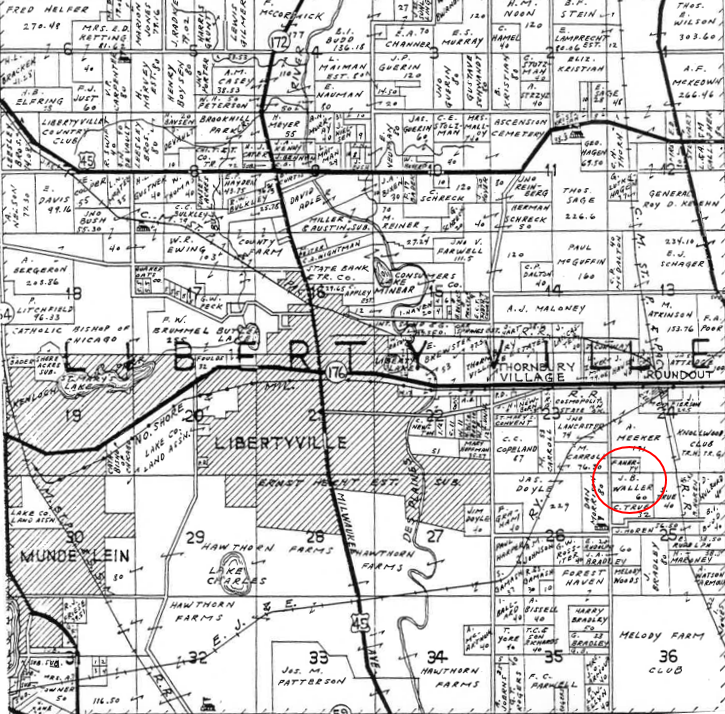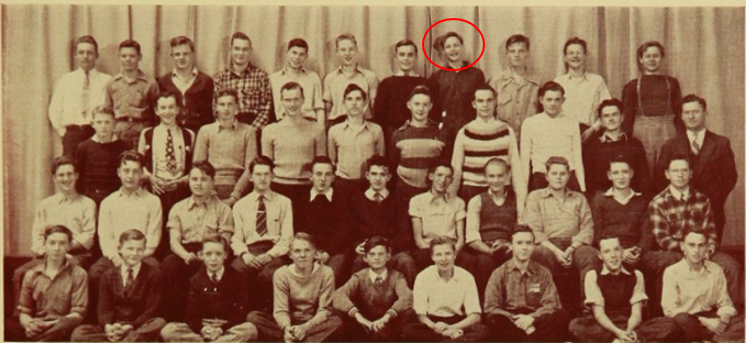Beginning with his breakthrough role in A Streetcar Named Desire to his somewhat…questionable performance in the 1996 adaptation of The Island of Dr. Moreau, Marlon Brando was one of the best-known actors of his day. But did you know that for a short time, Brando lived in, or at least on the outskirts of, Libertyville? With the Oscars only a few days away, I thought that this would be the perfect opportunity to do a mini-post about Brando’s life in our very own town.
Marlon Brando, nicknamed Bud early in childhood, was born April 3, 1924 in Omaha Nebraska to Marlon Brando Sr. and Dorothy “Dodie” Julia Brando, an actress in her own right and friend of Henry Fonda. Raised with his two older sisters, Frances and Jocelyn, life for the young Brando must have been difficult. Between his alcoholic mother and his philandering father, (Dodie would go on to have her own affair with an army officer in 1931) Brando’s early family life was permeated with tensions that could, and often did, erupt into intense arguments between his parents. One can imagine the situation was not helped by a series of uprootings, first moving to Evanston where Brando’s father’s worked at a chemical manufacturing plant in Chicago, and then again when Brando’s parents separated in 1935. The two eventually reconciled, and in summer 1938 the family moved to Libertyville.
The family settled into an old rambling farmhouse that had previously belonged to a J.B. Waller, located on the outskirts of Libertyville on Bradley road. The house, which according to Brando’s sister Jocelyn, was “usually a mess,” was furnished with a worn sofa, threadbare rugs, and in what seems to have been an attempt by Dodie to make known her dislike of what she perceived as Libertyville’s small-town values, a large painting of abolitionist John Brown. One can imagine this probably did not help the rumors that quickly sprung up around the newly arrived family, who neighbors viewed as being somewhat reclusive and a bit wild.

Also living on the property was Bill Booth, a horse trainer known for his hard drinking and womanizing, and Margaret, their live-in maid. Rounding out the farm were chickens, cows, horses and Dutchie, a black Great Dane that was Brando’s constant companion.
Attending Libertyville High School, the young Brando was immediately marked as an outsider. His grades from his previous schools were, at best, mediocre, and in a time when most boys came to school wearing dress clothes, Brando would arrive (usually late) wearing T-shirts and jeans looking, as a former classmate later remarked, as if he had “just crawled out from under a car” (Manso, p. 35). Brando would slink to his desk, not talking, and then sprawl, not sit, at his desk. Brando would later remark that “at Libertyville High, I was a bad student, chronic truant, and all-around incorrigible” (Brando, p. 32).

Always aware of how others would perceive him, Brando very quickly made a name for himself as the class, and possibly school, clown. Although multiple legends have grown around his antics, some of which contradict each other, some of the more verifiable pranks he pulled include: hanging a dead skunk on the football scoreboard (upwind of the classrooms of course), doing his French homework on toilet paper, and riding his bike in the school.
Outside of school, the young Brando had only a few close friends, which included Joe Spery and Bob “Bo” Hoskins with whom he started a very short lived band named Bud Brando and His Keg Liners, named after a beer advertised as being “keg lined”. He also participated in school Drama Club, which although he never actually appeared in any school plays, which one can imagine had an impact on his future choice of careers, as well as football and track. Like other teens his age he went on dates, although over the course of the three years at Libertyville High School he never had a steady girlfriend, instead opting to go on a serial dating spree with the prettiest girls.
More surprisingly, Brando also befriended Tom Rogers, the pastor of St. Lawrence Episcopal Church, located on West Church Street right across from the library. An anomaly for the Libertyville of the time, he was both liberal in his politics and rumored to be gay. He was nevertheless always on call for his parishioners. This status as an outsider may have been what attracted Brando and Dodie to him, although his sympathetic ear probably did not hurt. In later years, whenever Brando would return to Libertyville, he would always stop by the church to visit with the aging pastor, inquiring about his parish and, it is said, anonymously donating to needy families.
Starting in 1939, Brando began working at the Liberty Theater as an usher, as mentioned in my previous post. However, he disliked the stiff, formal uniform and would often forego the dress shirt underneath in favor of a simple undershirt, which was against the theatre’s dress code. This, in addition to increasingly mean spirited pranks, including throwing a string of firecrackers into the audience, saw him fired from the theater. According to his autobiography, he got revenge on the theater by stuffing rotten Limburger cheese, which according to Brando was almost “pure bacteria,” into the theater’s air-conditioning system.
Marlon Brando’s time in Libertyville ended in September 1941. There are rumors that Brando might have been expelled from school, ranging from skating in the hallways in class to being caught smoking. What is known is that by then his grades were so poor he was going to be held back a year and that in desperation, his father had decided to send Brando to the Shattuck Military Academy, hoping that the regimentation of the academy would straighten out his son. Brando was in short order expelled from Shattuck, after which he decided to follow his sister Jocelyn, who was herself an aspiring actress, to New York. The rest, of course, is history: Brando would go on to become a world-famous actor, winning multiple Academy and Golden Globe Awards, along with being nominated for the Directors Guild of America Awards. But for a short time, he lived in Libertyville and his name, to his friends at least, was Bud.
Brando, Marlon , and Robert Lindsey. Brando: Songs My Mother Taught Me. New York, NY: Random House, 1994.
Flint, Peter B. “Henry Fonda dies on coast at 77; Played 100 stage and screen roles.” New York Times (New York City), August 13, 1982. 2008. Accessed February 7, 2017. http://www.nytimes.com/1982/08/13/obituaries/henry-fonda-dies-on-coast-at-77-played-100-stage-and-screen-roles.html?pagewanted=all.
Libertyville High School, Nautilus 1940 Yearbook, (Libertyville, IL: Student body of the Libertyville Township High School), Cook Memorial Public Library District, pg. 22.
Lissau, Russell. “Acting Legend’s local ties date back to the 1930’s.” Daily Herald (Arlington Heights), July 3, 2004 pg. 1.
Manso, Peter. Brando: The Biography. New York, NY: Hyperion Books, 1994.
Waller, C.L. “Strolling down Marlon Brando’s memory lane.” Daily Herald ( Arlington Heights), January 20, 1995, sec. 5.
Discover more from Cook Memorial Public Library District
Subscribe to get the latest posts sent to your email.
Categories: Local History
Tags: Local History
